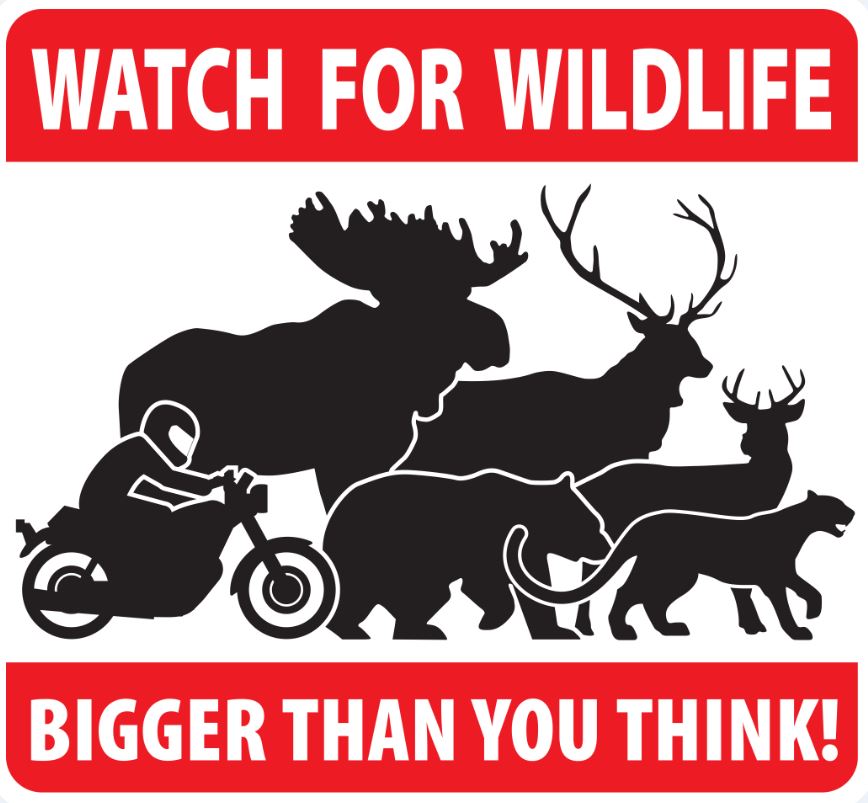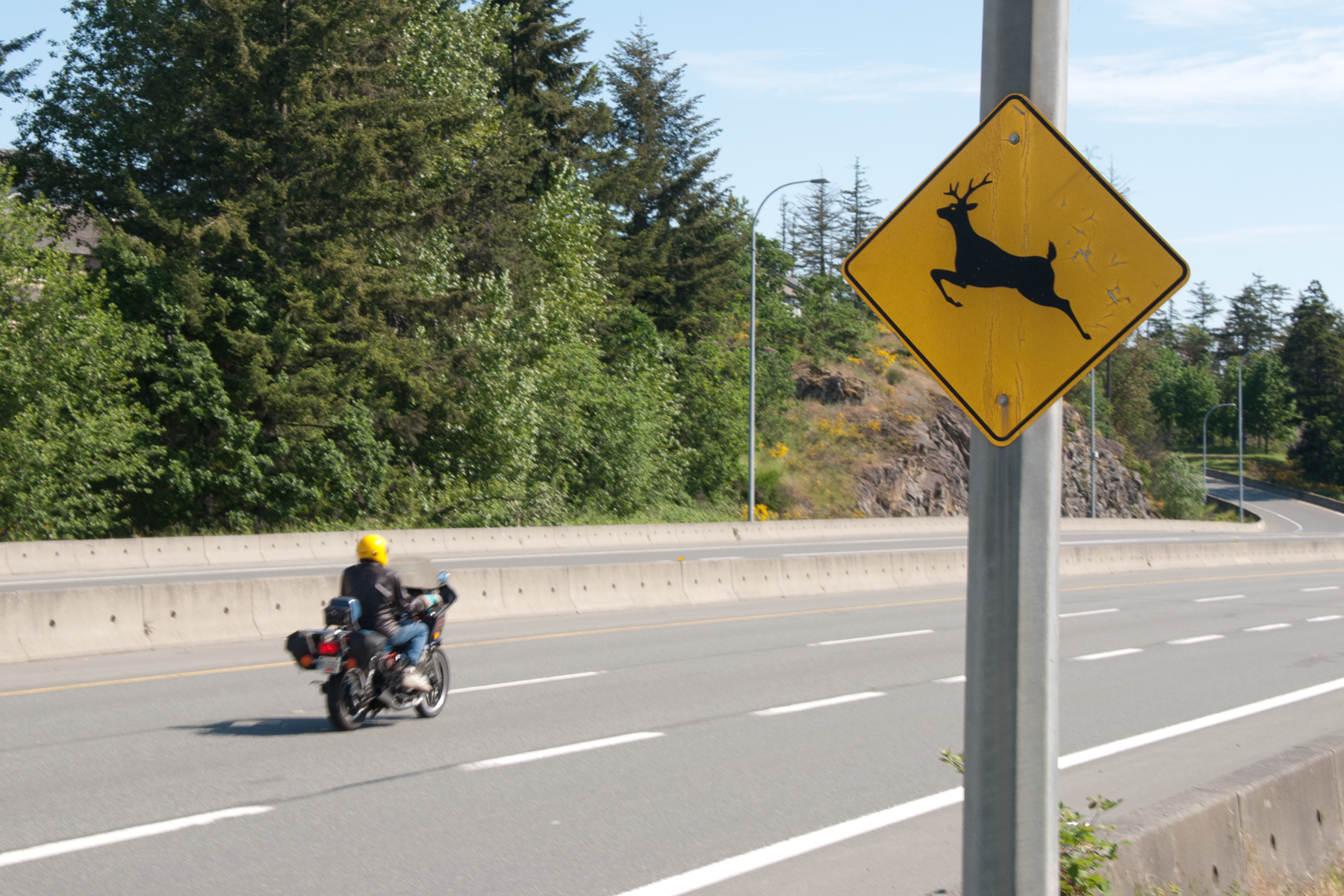 You probably know that May is Motorcycle Awareness Month – the time of year when we remind drivers to watch for motorcyclists who are back out on the road now that the better weather has returned. But did you know better weather increases another kind of risk for motorcyclists? It’s the risk of an unexpected encounter with roadside wildlife. There are many species of wildlife (big and small) in BC that are a real hazard for motorcyclists and, in order to reduce your risk of finding out first hand just how big a moose really is, we’ve put together a list of helpful tips to keep you, your motorcycle and wildlife safe on BC highways.
You probably know that May is Motorcycle Awareness Month – the time of year when we remind drivers to watch for motorcyclists who are back out on the road now that the better weather has returned. But did you know better weather increases another kind of risk for motorcyclists? It’s the risk of an unexpected encounter with roadside wildlife. There are many species of wildlife (big and small) in BC that are a real hazard for motorcyclists and, in order to reduce your risk of finding out first hand just how big a moose really is, we’ve put together a list of helpful tips to keep you, your motorcycle and wildlife safe on BC highways.
If you ride a motorcycle, you should:
- Watch for wildlife crossing signs. These signs are installed in locations where wildlife are known to cross highways.
- Obey speed limits. The faster you are going, the longer it will take to stop.
- Make sure your headlights and windscreens are clean, especially at night. Use your high beams when it’s safe to do so.
- Make sure your tires and brakes are in good shape and working properly.
- Don’t ride under the influence of alcohol, drugs or other substances, or if you are tired or if you have problems with your vision.
- Watch for groups of wild animals. If a deer runs in front of you, chances are there are more nearby. Slow down and keep an eye out for more crossing the highway.
- Stay in the centre lane, if possible. On a multi-lane road, the centre lane is your safest bet for avoiding a collision with a wild animal. This position gives you plenty of space; and in case your motorcycle startles a wild animal, it gives you more time to react if it darts onto the highway. If you need to move out of the way for faster traffic, let them pass and then return to the centre lane.
- Stay the course. If you see a wild animal, brake firmly and calmly and stay in your lane. Swerving could make you lose control of your vehicle and turn a bad situation into something worse.
- Use extra caution when riding your motorcycle at dawn and dusk in areas where wildlife may be present, as these are the times wildlife move the most.
- If you do ride at night, watch for the reflections of animal eyes. Animal eyes will brightly reflect a motorcycle’s headlight, making them easier to spot.
So, please remember, better weather means more motorcycles AND more wildlife on BC highways. Pay attention and remember you share the road with them all. Do you have any questions on this, or anything else the BC Ministry of Transportation and Infrastructure does? Let us know in the comments below.

Isa May Motorcycle Awareness Month this year as in previous years?
thanks,
Ross
Hi Ross,
Thanks for asking about May being Motorcycle Safety Awareness Month.
We are planning to highlight safety for riders and drivers throughout next month. Is there an aspect or concept of safety (for motorcycle riders and/or vehicle drivers), or a tip, that you think we should include?
John, well my “louder bike” has saved my butt numerous times and yes I drive the posted speed limit. So I disagree. Of course I don’t disagree with any of the other points you made. So despite whatever facts you “cut and paste”, my personal experience trumps your stats. Finally, loud pipes don’t necessarily equate to obnoxious either if you ride responsibility and respectfully.
Our experience was a case of Loud Pipes scared the deer (Big Foot) onto the road. We had just left Castle Rock Washington for a destination of Mount St. Helen, about an hour up the road. I was leading the way and riding in the left track of a two lane highway. My dear wife (pardon the pun) was following me in the right track of the lane. I should mention that the roadway had no shoulder and the brush came very close to the pavement in sections. Then without notice, a deer bolted out of the brush onto the roadway just after I had past it. It ran into the engine guard of my wife’s bike, taking her by surprise. Fortunately, in this case, my wife had absolutely no time to react other then to brace of impact. While travelling at 80 km/h (50 mph) she was able to stay upright and gradually slow to a stop. The engine guard had been bent back about 30 degrees and the highway peg was now bent back under the brake pedal. My wife was shaken but unhurt. But the bike had over $6000 damage done to it. Had the deer hit the front wheel, I am sure that there would have been serious injuries sustained or possibly worse. This is a case of a 950 Harley winning out over a mature deer. Ironically, when we returned to the scene of the accident the next day, we saw that a property owner had posted 6 or 7 signs by the road warning ‘Watch out for Deer’! Unfortunately these signs were about a mile past the accident. My wife was not quite sure what she had hit other than a furry thing. Of course I told her that it was Big Foot. The moral of the story is not only that Loud Pipes don’t always save lives but one must always be vigilant in watching out for moving animals.
Thanks for sharing your story about a too-close wildlife encounter, in Washington.
We especially appreciate that it comes with a moral — to be alert at all times, and that loud pipes can startle wildlife onto instead of away from the road. Glad that everything turned out okay for your wife — she sounds like a skilled rider. Whether it was a big deer or Big Foot, any collision would definitely make an impact!
Dear Editor,
Good advice in your piece on Bikes and Big Animals.
You may recall we exchanged notes on the Roosevelt
Elk herd transplanted into the Lytton area, and you
kindly got some additional info about them for me.
Here is the connection. I was driving South on Hwy. 97/TCH
near Lytton in the predawn light, saw the roadside
warning of an elk crossing, and then saw, for the
first time, a cow elk crossing the highway 200 yards
ahead.
I immediately slowed to 50 KPH, and as I spproached the
spot where the elk had crossed, as tempting as it was to
look left at the elk, I focused on the bush to the right.
Sure enough, a second cow elk came bursting out the
bush right in front of me. Now I wasn’t riding my bike, but
had I been doing the speed limit, that elk would have joined
me in the front seat of my venerable Chevy wagon!
As it was, I had time to stop, no problem, but that poor
cow was so scared by Big Red bearing down on her
that she tried to run up the steep road bank, fell, and
thrashed around with all four hooves in the air!
I pulled over and watched as she righted herself, to
be sure she wasn’t injured; not that I was about to get
out and administer first aid!
She was a little confused, ran back and forth across
the road, and the followed her companion up the trail
into the bush.
So, thanks TRANBC for the timely heads up! Hitting
an animal that size even in a big wagon would likely have
been fatal. On a bike? Forgeddabouddit!
Happy Trails
Ram lim’ Ryan Lake.
Hello again Ramblin’ Ryan and thank YOU so very much for sharing your story with us. This kind of anecdote is truly what we work toward and we love hearing from you. Until we chat again – safe travels.
Indeed.
I’m a big-time motorcycle enthusiast and “loud pipes save lives” is complete hogwash (no pun intended). If you want to stay alive on the road, you have to ride/drive for everyone else, especially now that texting and driving with earphones is commonplace. No-one is looking out for you, much less listening.
Besides, you’re making yourself deaf.
Speaking from experience, loud pipes most certainly gets the attention of drivers who are not paying attention and give advance notice to wildlife that you are coming their way.
Steve, that makes little to no sense, as the noise of your pipes is almost totally directed behind you, the sound up front is insignificant. What loud pipes do accomplish, however, is the resentment of locals and bylaws that restrict where/when we can ride.
The accumulated evidence overwhelmingly shows(https://canadamotoguide.com/2016/07/29/the-truth-about-loud-pipes/) that in accidents caused by other drivers, visibility is the main issue.
Headlights, reflective clothing and defensive driving will do more to keep you unharmed and riding far more than aftermarket headers and pipes will.